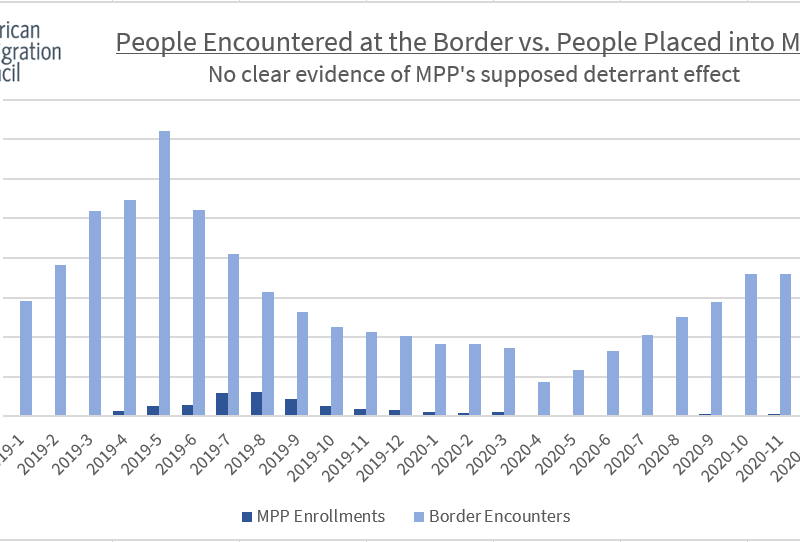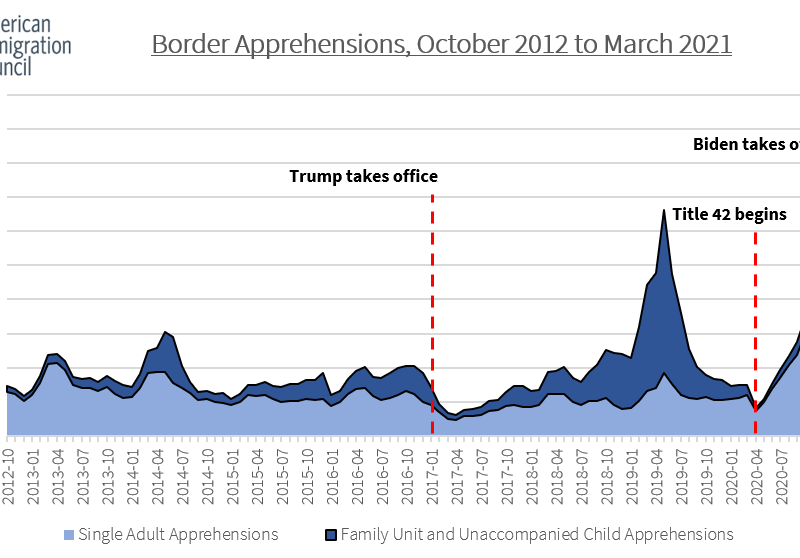Although Republicans supported President Trump’s cruel, ineffective immigration policies for years, they are currently attempting to politicize President Biden’s attempts to humanely manage the border and end Trump’s harsh and ineffective policies. Yet their efforts to portray any increase in border crossings as an indictment of the Biden administration ignores the fact that there is overwhelming evidence to suggest that the so-called “deterrence” policies of past administrations are ineffective at decreasing border crossings.
Experts agree: deterrence-focused policies don’t work at deterring immigrants from coming to the US.
- Washington Post: “Researchers Increasingly Find That Deterrence Has Only A Weak Effect On Reducing Unauthorized Immigration.” “The effectiveness of deterrence is notoriously difficult to measure; it is hard to isolate its effects from the other factors that drive migration. But researchers increasingly find that deterrence has only a weak effect on reducing unauthorized immigration.” [Washington Post, 5/31/18]
- Deterrence Does Not Stop Migration So Much As Redirect It. “Perhaps more important, deterrence does not seem to stop migration so much as redirect it. […] Indeed, research on border control has shown that efforts to obstruct or deter border crossings by constructing physical barriers or intercepting migrants at sea have primarily redirected migration flows toward increasingly dangerous alternative routes. And such policies actually appear to encourage migrants to hire human traffickers to guide them through.” [Washington Post, 5/31/18]
- Immigrant Families “Aren’t Abandoning Their Home Countries To Take Advantage Of Supposedly Lax US Immigration Policy — They’re Choosing Between A Homeland Where They Worry Their Family Has No Chance Of Survival And The US, Where They Just Might.” Analysis from political scientist Tom K. Wong of UC San Diego in 2018 “shows that the past two attempted crackdowns on families crossing the border illegally — one under President Obama in summer 2014, and one under President Trump in summer 2017 — didn’t have a measurable effect on apprehensions at the border. The finding suggests that Central American families aren’t abandoning their home countries to take advantage of supposedly lax US immigration policy — they’re choosing between a homeland where they worry their family has no chance at survival and the US, where they just might.” [Vox, 7/24/18]
The numbers back this up. Even Trump’s cruel family separation policy did not deter immigrant families.
- The 2017 Family Separation Pilot Program Was Followed By An Increase In The Number Of Families Crossing Into The Area Where The Policy Was Rolled Out. “Using family separation as a means of preventing unauthorized border crossings, however, does not have a clear record of success. Vox reported [in 2018] that a 2017 family separation pilot program was actually followed by an increase in the number of family crossings in El Paso, where it was rolled out. Of course, this does not mean that the policy caused more families to enter the country illegally. But it does call into question whether family separation deters unauthorized immigration.” [Washington Post, 5/31/18]
- The Number Of Border Patrol Apprehensions Did Not Decrease As A Result Of Family Separation Policies. “The monthly number of U.S. Border Patrol apprehensions of families at the southwest border has not decreased as a result of family separation. Figure 1 illustrates the relationship between the use of family separation and the monthly number of apprehensions while controlling for the expanded use of family detention in July 2014. It shows that the monthly number of apprehensions was increasing before the expanded use of family detention in July 2014, continued to increase after, and increased again after the zero-tolerance pilot in July 2017.” [Center for American Progress, 7/24/18]
In fact, President Trump’s overarching immigration policies were ineffective at slowing immigration, as border apprehensions increased every year from from 2017 to 2019 under his watch, and the number of family members apprehended reached a high not seen since 2012.
- The Trump Administration’s Deterrence Programs Inflicted Enormous Cruelty Without Any Long-Term Effect Decreasing the Numbers. “But even the extreme and widely publicized practice of family separation didn’t deter people from coming to the United States. By the end of 2018, the number of families and children coming to the border was going up again. In 2019, the Trump administration tried multiple measures to prevent people from seeking asylum, including metering and asylum turn-backs and the so-called ‘Migrant Protection Protocols’ (MPP). […] By the end of 2020, thousands of families and unaccompanied children were already coming to the border and many were being released. The Trump administration’s deterrence programs inflicted enormous cruelty without any long-term effect.” [Immigration Impact, 4/2/21]
- From 2017 To 2019 The Number Of Border Apprehensions Increased Every Year As Trump’s Presidency Progressed. [CBP, accessed 4/5/21]
- 2017-2019: There Were An Average Of Over 524,000 Border Apprehensions Each Year While The Average During The Presidency Of Barack Obama There Were An Average Of 423,102 Apprehensions Each Year. [CBP, accessed 4/5/21]
- The Current Increase In Border Activity Began Last April, As From April 2020 through December 2020, There Was A 332% Increase In Border Encounters. According to CBP data, there were 17,106 border encounters in April 2020, and 74,018 border encounters in December 2020. [CBP, 3/10/21]
- 2018: Roughly 163,000 Family Members Were Apprehended At The Border, More Than Three Times The Number In 2017 And The Highest Number Since 2012. “In the months leading up to the [2018 partial government] shutdown, there was a large increase in the number of people in family units apprehended at the border. Monthly family apprehensions subsequently hit new highs each month from September through December, according to data going back to 2012. There were nearly 17,000 family member apprehensions in September, more than 23,000 in October, about 25,000 in November and a record of more than 27,000 in December. All told, roughly 163,000 family members were apprehended last year – more than three times as many as in 2017, and the highest number since at least 2012.” [Pew Research Center, 1/16/19]
- Trump’s Migration Protection Protocols Policy Did Not Work As A Deterrent: At Its Height Less Than One-Third Of People Encountered Were Sent Back to Mexico Under The Program, And In March 2020 Just 1.19 Percent Of People Encountered Were Subject To MPP. “MPP [Migration Protection Protocols] did not work as a deterrent. This is flagrantly false. At the height of MPP in August 2019 (months after numbers started dropping), less than 1/3 of people encountered were sent back to Mexico. And since March 2020, just 1.19% of people encountered were subject to MPP.” [Aaron Reichlin-Melnick, 3/30/21]
[Aaron Reichlin-Melnick, 3/30/21]
The temporary decline in apprehensions and migration during 2020 was not due to Trump’s deterrence policies but because governments across the globe shut down their borders due to the coronavirus.
- The Decline In US Border Apprehensions In 2020 Was Due To The COVID-19 Pandemic, With Most Governments Closing Their Borders To Stem The Spread, Including Mexico Restricting Nonessential Travel Across Its Border, And El Salvador, Guatemala, And Honduras Also Implementing Travel Restrictions. “There were 400,651 apprehensions in the 2020 fiscal year (October 2019-September 2020), a 53% decrease from the previous fiscal year, when apprehensions soared to their highest level in 12 years. The fiscal 2020 total was generally on par with other recent years and far below the 1,643,679 recorded in the peak year of 2000. Border apprehensions regularly exceeded 1 million per fiscal year during the 1980s, 1990s and 2000s. The decrease in apprehensions comes as the movement of migrants in the Americas and worldwide has slowed during the COVID-19 outbreak, with governments fully or partially closing their borders to stem its spread. In March, Mexico restricted nonessential travel across its border with the United States, while the governments of El Salvador, Guatemala and Honduras also implemented restrictions on movement. Most migrants apprehended at the U.S.-Mexico border in recent years have come from Mexico and Central American nations.” [Pew Research Center, 11/4/20]
- The 2020 Border Shut Down Due To COVID-19 Did Not Deter Prospective Immigrants But Rather Delayed Their Journey. “In other words, in fiscal year 2021, it appears that migrants are continuing to enter the United States in the same numbers as in fiscal year 2019 — plus the pent-up demand from people who would have come in fiscal year 2020, but for the pandemic. That’s shown in the first figure, earlier, in which the blue trend line for the five months of data available for fiscal year 2021 (October, November, December, January and February) neatly reflects the trend line for fiscal year 2019 — plus the difference between fiscal year 2020 and fiscal year 2019. This suggests that Title 42 expulsions delayed prospective migrants rather than deterred them — and they’re arriving now.” [Washington Post, 3/25/21]
- Migration Policy Institute President Emeritus: “The Pandemic Has Essentially […] Stopped International Migration And Mobility Dead In Its Tracks.” “The pandemic has essentially — not absolutely, but essentially — stopped international migration and mobility dead in its tracks,” said Demetrios G. Papademetriou, co-founder and president emeritus of the Migration Policy Institute in Washington.” [New York Times, 5/12/20]
- Pew Research Center: The Coronavirus Pandemic Forced The Virtual Closure Of The Southwestern Border And Slowed Migration Across The World. “The number of monthly apprehensions had fallen to just 16,182 in April 2020, shortly after the coronavirus pandemic forced the virtual closure of the southwestern border and slowed migration across much of the world.” [Pew Research Center, 3/15/21]
In fact, Trump’s overuse of Title 42 during 2020 helped lead to the increase at the border we are seeing now.
- In Response To The COVID-19 Pandemic, The Trump Administration Implemented Title 42, A Health Law That Allowed The CDC Director To Prohibit The Introduction Of People Who May Introduce A Communicable Disease Into The United States, Which Allowed The Border Patrol To Expel Migrants Arriving At The Border. “On March 20, 2020, the Department of Health and Human Services (HHS) issued an emergency regulation to implement a specific aspect of U.S. health law. Section 265 of U.S. Code Title 42 permits the Director of the Centers for Disease Control and Prevention (CDC) to ‘prohibit … the introduction’ into the United States of individuals when the Director believes that ‘there is serious danger of the introduction of [a communicable] disease into the United States.’ […] After the CDC order was issued, the Border Patrol began to expel migrants arriving at the border. Under an agreement reached with the Mexican government in late March 2020, the Border Patrol began sending most Mexican, Guatemalan, Honduran, and Salvadoran families and single adults to Mexico.” [American Immigration Council, 3/29/21]
- Title 42 Was A Driving Force Behind The 2020-2021 Increase In Border Apprehensions, And Since Its Implementation By President Trump Border Apprehensions Have Increased As Immigrants Are Incentivized To Repeatedly Try To Cross The Border. “Despite claims that Title 42 is necessary to prevent individuals with COVID-19 from crossing into the United States, Title 42 has had the counterproductive effect of significantly increasing the number of arrests at the border. That is because under Title 42, individuals who are expelled to Mexico within hours after apprehension can simply try again a second or third time in hopes of getting through. This increase in apprehensions has been seen most among single adults who are not seeking asylum. Before the pandemic began, just 7% of people arrested at the border had crossed the border more than once, but by October 2020, 40% of all people arrested had crossed the border multiple times that year. This has led to a dramatic shift in the demographics of border arrests, with the number of encounters of single adults rising to levels not seen in over a decade […].” [American Immigration Council, 3/29/21]
[American Immigration Council, 3/29/21]



